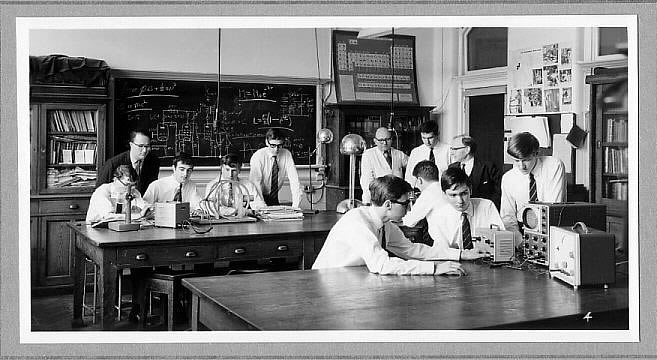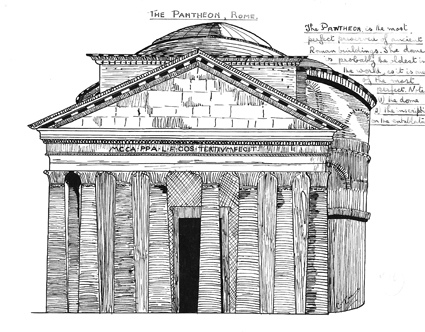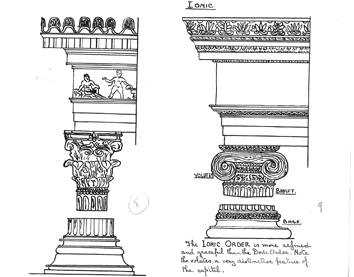| STEM
Philistines[1,2] by John
Swash
| The White Heat of Technology After
Labour's victory in the 1964 General Election, Prime Minister Harold Wilson and
Tony Benn coined the phrase "white heat of technology."[3]
The phrase has become synonymous with Wilson's vision for a modern, technologically
advanced Britain. It is often cited as an example of his commitment to science
and technology and his belief that they were key to Britain's future success.
A new Britain would be forged in the "white
heat" of a technological revolution and we would be part of it. They aimed
to educate more of the population in science and technology so that the UK could
compete in this exciting new age of technological advances epitomised by Concorde
and the opening of the Post Office Tower in London.
However, the "white
heat of technology" was not just empty rhetoric. It had real-world consequences,
especially for students like ourselves who were studying for science A-levels
during 1964-66. At WLBHS, the number of students studying science A-levels in
1966 already outnumbered those studying Arts and Humanities by 2:1, a significant
shift from 1959 when the numbers were almost equal.
| WLBHS upper 6th
numbers | 6A
Science | 6A
Modern | | 1959 |
27 | 25 |
| 1966 |
37 | 17 |
There were even bigger changes in the university
education we were about to embark upon. The existing Colleges of Advanced Technology
(CATS), Bradford and Salford, for example, became brand new universities in time
for some of my 6th-form classmates, in this photo, to enrol. Elsewhere, university
science courses were increased in size so that lecture theatres and labs were
filled to capacity. Additionally, 30 new polytechnics, teacher training colleges
and the Open University were established. For the first time the education budget
exceeded that for defence. | | 
Science
6th form in Physics lab just before A levels
, 1966 | | | Arts
v. Science -The Empire Fights back. During my years
in the Science 6th form at WLBHS, the education authorities decreed that we should
all be given some arts education to prevent us from becoming complete philistines.
Was this reaction just a case of the arts and humanities "empire" striking
back to preserve their jobs, I wonder? | |
Accordingly, we spent a term reading "La Vie
de Madame Curie" with Ben Baldry and also attended a series of illustrated
lectures by Mr. Mounsden on the history of architecture. Many of us may have been
tempted to pay little or no attention to these extracurricular arts lessons. In
my case, however, the teachers made a good choice of topics.
Mousey's
slideshows particularly captured my attention, taking us on a journey from the
Beehive tombs and Lion gate at Mycenae, via Egyptian, Greek, and Roman temples,
to the Dome of the Hagia Sophia Basilica in Constantinople and the magnificent
flying buttresses of gothic cathedrals like Notre Dame. Paul Haigh, an ex WLBHS
student who became an architect, commented to me that Mounsden made them draw
every illustration in Fletcher-Bannister's tome "A History of Architecture
by the Comparative Method" so we were probably given a small dose of that.
| | At
the time I never envisaged visiting any of the archeological and architectural
sites Mousey mentioned but I have been lucky enough to visit most of them. The
ability to distinguish Ionic, Doric, and Corinthian columns in visits to archaeological
sites and the British Museum gained me more kudos than Newton's Laws of Motion
ever did. What a pity we never had a field trip.We
could have found suitable architectural examples literally on our front doorstep
and a little further afield in Holbeck where Temple Mill was a full-sized replica
of the Egyptian temple of Horus at Edfu. , but they were covered in a century's
worth of Leeds soot until building facades were revealed by stone-cleaning in
the 1970s. | 
Replica
classical temple columns in the portico at the school's main entrance. |
| 
|
<Temple Mill, was built in 1840 by John Marshall, a flax-spinner.
The mill was designed by engineer David Roberts and architect Ignatius Bonomi.
It was built on a two-acre site in Holbeck and is a replica of the Temple of Horus
in Edfu, Egypt. The mill boasted many unique features including ducts for air-conditioning,
a giant obelisk for a chimney, and a glass roof that was later covered in grass
for sheep grazing. John Marshall became one of the first millionaires of the industrial
revolution and was MP for Yorkshire between 1826-1830. Today, the Grade I listed
building is used as offices. Who knew we had this in Leeds? Just think I
could have saved myself that Nile Cruise if I had only taken a Leeds Corporation
bus to Holbeck in my teens! | | To
my surprise, some years ago I received a school exercise book with wonderful penmanship,
which I instantly recognised as notes from the same course. It was written by
an old boy who wanted to become an architect, and his daughter sent it to me.
The old boy who wrote the architecture notes was Geoffrey Clayton Cave. He is
in the 1941-1943 cricket team photos. Unfortunately, he did not achieve his ambition
to become an architect but went into banking. I have included some illustrations
from his notebook below. | | 
Designs of Egyptian temple column
| 
| |
| The Scarab or dung beetle often used in Egyptian design. It appears over
the door in the replica Temple in Leeds ( see photo above) | |

The Pantheon
, Rome
| 
| | | Greek column design. Ionic Order |
| Afterthoughts | |
In retrospect did any of it rub off on us? Are scientists/engineers
of that generation slightly more cultured than they might otherwise have been?
Please take a moment to answer this "scientific" questionnaire:
On a scale of 1 to 10, how much do you appreciate and engage with culture
and the arts?
Are you a complete philistine (1) or a sophisticated culture
vulture (10)? I can only speak for myself but
I remember talking to an English student who was carrying a stack of books to
study for her finals, and found that I had read several of them myself for recreation.
I doubt the opposite scenario would ever happen, where an art student would pick
up a book on, say, Quantum Mechanics for leisure time reading; maybe in a parallel
universe! Many arty people who bought Prof. Stephen Hawking's popular science
book "A Brief History of Time" admit to never reading more than a few
pages.. It is peculiar that in the UK its acceptable
for members establishment to be almost proud of their technical ignorance as long
as they can spout eloquently about opera or the classics. Boris "Cinncinatus"
Johnson comes to mind. After the 2008 financial crash I didn't know whether to
laugh or cry when a parliamentary enquiry asked each board member of the failed
Royal Bank of Scotland in turn whether any of them held a basic banking qualification.
You can guess the answer. As recently as 2019, only 1 in 10 fast track graduates
to the Civil Service had a science degree. Fast
forward to 2023, and I find it ironic that the government is now concerned that
too few of our 6th formers choose STEM subjects, and the curriculum is being altered
once again so that English and Maths are compulsory to age 18. At least they will
be numerate and literate before they choose to study for a "Mickey Mouse"
degree, in film studies or Beatles studies, for example. A
difficult choice but I am sure they can work it out.
The long-standing conflict between arts and science may finally be over thanks
to the development of a powerful weapon by the STEM community -Artificial Intelligence.
AI represents a triumph for the "science nerds" as it is being used
first in the creative arts sector where it is already causing a paradigm shift
in the way things are done. | Notes:
1.
STEM -Modern UK educational acronym means educating students in four specific
disciplines, namely, Science, Technology, Engineering, and Mathematics
2.
Philistine-A person who is hostile or indifferent to culture and the arts.
Similar words: lowbrow, anti-intellectual, materialist, boor, ignoramus, barbarian.
primitive, savage, brute, vulgarian.
3. The phrase "white heat of technology"
was coined by Harold Wilson, the Labour Prime Minister of the United Kingdom (1964-70),
and Tony Benn in 1963.
| |